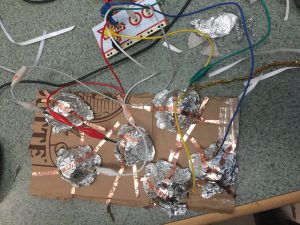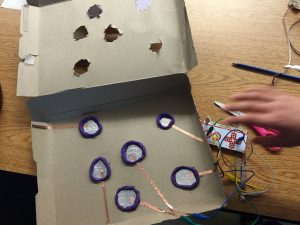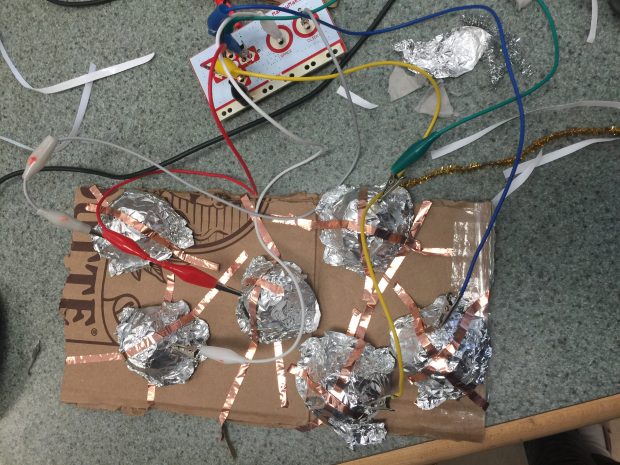Why? Why? Why? This question seems to come at me a thousand times a day from students, staff members, and my own three children. This ongoing inquisition can range from simple yes and no questions, to complex concepts requiring deep explanation. What is tempting is to provide answers. That shoot from the hip response in order to solve the problem, answer the question, provide the information, and move on. This method of me simply giving the answers was causing a crisis of inquiry in my world and despite me attempting to provide answers as a solution, it actually increased the volume of questions I was being asked…because I was the easy answer. This ask and get an answer was not proving to be deep learning for any party involved.
The questions are actually a good thing, a crucial element to examining one’s own understanding as well as challenge assumptions and conceptions (or in many cases mis-conceptions). We intuitively make sense of the world in any way we can based on our everyday experiences and will structure an understanding prior to any formal “education” on the matter (Confrey, 1990; Fouche, 2015; Vosniadou & Brewer, 1992). Right or wrong, this thirst for understanding is innate to the human mind and drives our learning. In fact, certain kinds of misconceptions which students experience are actually intrinsic to the growth of scientific understanding (Confrey, 1990). Heather demonstrated this confident construction of private theories. These private theories meant to be a jumping off point for inquiry and not an end point for information acquisition. It is safe to make clear that we can no longer assume that students are entering our classrooms as a blank slate ready to receive the information to begin their construction of understanding, or having received the correct prior knowledge based on previous years of instruction alone (Confrey, 1990). The key stone to creating conditions for flexibility of learning is to question our students’ understanding and private theories in order to challenge their misconceptions and plan appropriate inquiry opportunities (Confrey, 1990; Fouche, 2015). We also must find the misconceptions and make them clear. Heather’s teacher needed to know not only what she didn’t know, but what she thought she knew as well in order to plan. This to me really explained the use of KWL organizers in classrooms prior to beginning a unit of study. Taking the time to ask “what do you know” being a crucial first step. Teachers can make great strides in STEM education if they “prepare ahead of time questions that will do three things: elicit prior knowledge, uncover student misconceptions, and move students toward their conceptual goal” (Fouche, 2015, p.64).
Now enters the ultimate educational temptation…to find provide answers to the misconceptions or missing information. Instead the challenge is to use predictive questioning and give time for inquiry, observation, and explanation based on these misconceptions (Fouche, 2015) in order allow children an opportunity to reinterpret their presuppositions based on these new experiences (Vosniadou & Brewer, 1992). Note the word experiences, it was personal experiences after all that led us to create our initial private theories and it will take experiences to reconstruct our understanding. “All of us need time for our confusion if we are to build the breadth and depth that give significance to our knowledge” (Confrey, 1990, p. 82). It is an incredibly tempting to speed this process up by giving students the answers when you see them struggling.
I think this Constructivist pedagogy of teaching questions instead of answers leads to a deeper experiential based understanding especially when it comes to a makerspace environment. This hands on exploration of concepts as opposed to rote memorization allows for a solid foundation of understanding that has been built as opposed to information given in the hopes of retention in longer term memory. In teaching a Grade 5 science class the Electricity unit I decided to use a Makey Makey. The Makey Makey is an electronic invention kit that is full of wonder and whimsy and is hugely engaging to students as well as an opportunity to experience exploration of electrical components. This kit is full of coloured wires and alligator clips. It was amazing to me the misconceptions of the colour of the wire mattering (too many action movies?), the fear of getting electrocuted if you touched the wire (more movies?), and that the Makey Makey was “magic”. By taking the time to question and challenge these understandings led to a purposeful investigation comparing conductivity and electrical current. The students had a reason to challenge their understanding in order to build a successful operation game.

Misconceptions come to life

The reconstruction of understanding after challenging misconceptions
This predictive questioning and hands on inquiry seems to make sense in science class. We have a golden opportunity to use inquiry to improve our understanding and a chance to use technology to observe and interact with the phenomena….but what does this mean for mathematics when conceptual understanding is our greatest area of weakness (according to our PAT regression analysis) but we do not follow the same procedures to uncover misconceptions, or engage in inquiry. We tend to ask questions and teach answers.
Can this same method of questioning be applied to math? Have you authentically engaged in authentic inquiry as a way to construct meaning in your math classes?
Trish
PS This is a video that inspired me to become a teacher that asked more questions instead of teaching answers. I hope that it inspires you too.
References
Confrey, J. (1990). A review of the research on student conceptions in mathematics, science, and programming. Review of research in education, 16, 3-56
Fouché, J. (2015). Predicting Student Misconceptions in Science. Educational Leadership, 73(1), 60-65. Retrieved January 8, 2018, from http://www.ascd.org/publications/educational-leadership/sept15/vol73/num01/Predicting-Student-Misconceptions-in-Science.aspx
Vosniadou, S., & Brewer, W. F. (1992). Mental models of the earth: A study of conceptual change in childhood. Cognitive psychology, 24(4), 535-585

Hi Trisha,
I loved your opening description of how providing the answers to questions “was providing a crisis of inquiry in my world”. I agree that it’s so much easier as a teacher just to tell the students the right answer, provide the solution, the appropriate steps, the “what” to think. It’s faster, it’s less “messy”, but you make an important point that it reinforces the misconception that the teacher’s job is to do the thinking and answering and the students’ jobs are to do the passive receiving of those answers. This is damaging to the development of student-focused learning habits and the curiosity and risk-taking required for effective inquiry.
You also make a good point about how we cannot assume that our students have had misconceptions properly corrected in their previous years of schooling. I think this is often more hidden in Science, where the private theories, even of “good” students like Heather, are hidden even after preliminary conversations, but they are seen most clearly in Math where the foundational skills that are missing becoming glaringly obvious when students are asked to perform higher order applications. When students still don’t know their multiplication tables or how to divide, for example, many other tasks become cumbersome. The use of KWL and purposeful planning to find and address misconceptions is critical. I’ve used “pre-tests” or “diagnostic tests” at the start of units to help me identify what each student already knew and where we needed to focus on building new learning or correcting errors. It made for a very differentiated but long unit.
The question is, do teachers limit teaching the grade-level content to go back and address the misconceptions that were identified to be conquered in earlier grades/units? Again as I mentioned in one of my posts, I feel that teachers who are committed to actually promoting student learning may need to make a conscious choice to disconnect themselves from the pressures of “covering” the massive amount of specific expectations (PLOs in BC?) in the curriculum documents, and instead be reconciled to the reality that we only have the time to guide students to really grasp only a few of the “big ideas” or key concepts found in this unit of study, especially if students come into our classes with last year’s misconceptions or gaps still unaddressed.
Thanks for sharing! 🙂
Jan
Jan you bring up a great question that is plaguing our classrooms. How does a teacher get through the immense number of learning outcomes for their grade level and also go back to other grade level outcomes to address missing information and skills. I think to some point our content area subjects like Social and Science we let go of missed information, rely on the skill outcomes, and move forward with the new knowledge outcomes from the current year of study. In a spiraling curriculum like Math this simply isn’t possible as each outcome creates the base of learning to support the next. I cannot teach multiplication and division if students haven’t mastered the basics of addition and subtraction. With our incredibly diverse populations in our classrooms teachers more and more are faced with multiple special needs students, English Language Learners, transient students and more. One teacher I met with this month said she has 4 grade levels of differing math abilities in her Grade 4 classroom. She is trying to work with students at grade level along with those working at a kindergarten, grade 1, grade 3, and grade 4 levels depending upon the particular outcome and missing skill set. She doesn’t have a choice not to re-teach, but doesn’t have the time and feels she isn’t doing justice to the students who are at level and need to learn grade 5 material. This is a problem with no easy solution.
Hi Trish,
Thanks for your post and the amazing video! Your post fully resonates with me. As a young teacher at the university, I found one day that I am teaching answers to questions that the students never had. Therefore, they are not really able to make meaningful connections of my answers and thus did not really show in-depth learning.
It seems much better to make students define their questions (= problems) first on their own, and then let them find the answer. This constructivist approach seems indeed much more efficient and also a lot more fun to both – students and teachers. Case study 1 shows for me how successful this can be.
I know, however, that some of my colleagues are doubtful on this approach. They fear that are not able to “cover” all the content given in the curriculum and that students will not learn the needed basics, if the teacher lets go a bit of control on the learning process. How would you respond to this?
Elske
I completely agree and we experience the same dialogue here in my district. “Inquiry” is seen as extra, optional, and foundational to learning the basics but rather a chance to create a project once you have learned everything you need to know first. Due to the immense amount to Specific Learning Outcomes (SLOs) in our Program of Studies many teachers say that they do not have time to allow for inquiry learning because they have too much content to “get through”. What is frustrating about this statement to me is the notion of simply checking off a list of SLOs that you either spoke about or projected notes about in class as teaching. You cannot brush off your hands and claim that the delivery of the material counts as our teaching practice. Student learning is key. I question what method is proving to show deeper understanding, application, and retention of the content. Take mastering the basic facts in math for example. There are many parental and political voices calling for a return to the basics as a way to answer our poor PAT scores in conceptual understanding in math. With a return the basics they are also meaning a return to the basics of how we used to teach, with rote memorization and algorithms. I agree that the basics are foundational learning that must be covered, but the method of memorization is not providing an opportunity for deeper understanding. I feel inquiry is still a valid method for this, a chance to explore and understand.